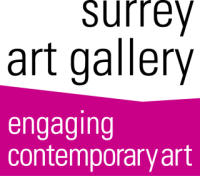

Credit: Installation image of Underground by Kristen Roos. Photo by Scott Massey.
Open Sound 2012
The hidden, invisible, and voiceless are given expression in these artworks.
Date & time
Address
Tickets & pricing
Free
Exhibition Details
In 1917, the French composer Erik Satie composed his first piece of musique d’ameublement (furniture music), music deliberately intended to sink into the background ambiance of a room much like arrangements of furniture are meant to be conducive to comfortable conversation. Kristen Roos’ new work Underground operates in the foyer of the Surrey Arts Centre with this history of lobby-oriented music in mind.
The work is integrated into two existing sofas that are hard-wired to emit ambient musical compositions in a way the listener can both feel and hear. The artist has installed speakers and tactile transducers into the furnishings so that they vibrate and generate low-level sound that is almost only sensible to the sitter. The sound is derived from recordings made in the basement of the Surrey Arts Centre, including the mechanical room.
Alex Grünenfelder’s Audio Migration is a four-channel, site-specific sound installation that uses field recordings of local birds, human speech, and other activities on either side of the nature and culture divide to explore the formal and conceptual similarities, differences, and interactions between human and non-human life.
Debashis Sinha’s Hati is a sculptural installation incorporating multiple strands of ghungru bells (ankle bells used in South Indian dancing) and a tactile transducer speaker. These kinetic sculptural elements use recorded elephant infrasonic communication, combined with spoken word elements from a fictional Ganesha character, to address histories of South Asian performance and animal-human relations.
Read more about these three projects in the exhibition brochure.
Artists:
Kristen Roos
Alex Grunenfelder
Debashis Sinha
Sound Thinking 2012
Snap, Crackle, Hum—Electromagnetism, Sound, and Audio Art
Electromagnetism has become a key feature of modern sound performance, recording, and broadcasting. Scholars of sound are increasingly looking to the history of man-made electricity, the enormous field of electrical devices, and the development of new technologies of communication and recent studies of geophysical electromagnetism to reconsider the nature and fundamentals of sound.
Much of this recent research, such as the work by sound theorist and conference keynote Douglas Kahn, is changing how we conceive of our human landscapes and “the environment” more broadly. Similarly, contemporary sound artists working with both new technologies and outmoded ones, are investigating the fundamentals of electromagnetism to create new sound environments and sculpture.
The 4th annual Sound Thinking Symposium takes sound art, electromagnetism, and electricity as a starting point for a variety of explorations, including the complex relationships between electromagnetism, technology, nature and culture, the aesthetics, poetics and history of electromagnetic sound, and how electromagnetic technologies are reshaping human subjectivity and the social world.
It includes a series of presentations and performances on the nature of hearing, making, and transmitting sound by audio-art specialists and technologists. Snap, Crackle, Hum… creates a forum for discussion and presentations on recent debates on the role of electromagnetism in recent sound art, in social life, and the natural world.
Participants: Douglas Kahn (keynote), Carrie Bodle, Alejandra Bronfman, Peter Courtemanche, Gordon Djurdjevic, Celia King & Joel Snowden, Kristin Roos, Jay Budney Johnson
Conveners: Ross Birdwise & Jordan Strom
View the program and participant bios.